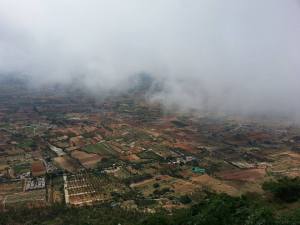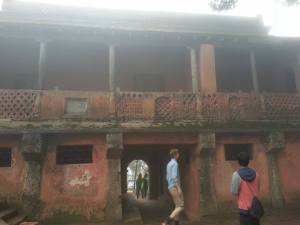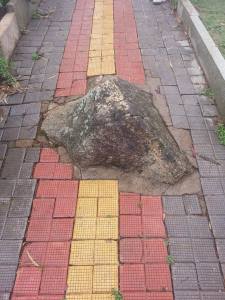Food & Health
I really miss really good Korean food. Indian cuisine is great, don’t get me wrong. But growing up in a Korean household, my taste buds are used to the subtle spices and intricacies that make up Korean food. This is great though, because when I go back home, I know I am definitely going to appreciate and love all of the food I left behind. This week we found some new places to eat, including Phobidden Fruit, Chinita, and 3Oh3. Jacob and I also found a cool cafe in Koramangala (one of the districts of Bangalore) called Dyu Art Cafe. Here are some pics:
 It’s not as great as the cafe near my apartment (mostly because it’s farther and has no WiFi), but it’s pretty cozy and definitely a great place to read. Their French toast was pretty good and they have awesome coffee that they serve black. I have never been so happy to see black coffee.
It’s not as great as the cafe near my apartment (mostly because it’s farther and has no WiFi), but it’s pretty cozy and definitely a great place to read. Their French toast was pretty good and they have awesome coffee that they serve black. I have never been so happy to see black coffee.
Work
Things have been picking up at Janalakshmi. Currently I am married to three different projects:
- The one that I am almost finished with is a cross-analysis between the operational and financial characteristics of Janalakshmi and SKS, the second largest microfinance institution in India and one of my organization’s main competitors. I spent a good amount of time reading the P&L (profit & loss) reports, balance sheets, and quarterly reports of both firms, trying my best to figure out which information is the most precise and reorganizing the data to evaluate the metrics as percentages of the average loan portfolios over quarters and fiscal years (fiscal years in India start in April and end in May, unlike American companies). It was interesting to see the financial records of microfinance institutions and what they deem important. I spent a little bit of time looking at LBO (leveraged buy-out) models last summer and the metrics that they prioritize are pretty different from MFIs. It makes sense though since private equity firms value companies and their performance metrics as percentages of their revenues and cash flows. I’m supposed to present my data and observations of trends and patterns to the CEO on Monday. Should be fun.
- The Chief Innovation and Strategy Officer has instructed me to create dashboards for the company’s payment-related projects. In other words, I need to build presentations that show how the different components of the payment program have been doing weekly, monthly, and yearly. Therefore, I’ve been running around to different departments asking for their data and just my luck, none of the projects are evaluated the same way. In addition, I was told to figure out more effective, efficient methods to show how well they’re doing (of course, after parsing though all of the spreadsheets), so I feel slightly overwhelmed. This is probably how I’m going to be spending most of my week (and probably next week too).
- I spent a day going through a database full M&A valuations, private companies’ financials, and other investor-related information. It was basically for me to see if that specific website was useful. We are currently trying to figure out methods of valuing companies in the e-commerce and payment industries. It’s not really appropriate to see how much these kinds of firms are worth by just doing DCF (discounted cash flow) or revenue/EBITDA (earnings before interest, taxes, depreciation, amortization)/PAT (profit after tax) multiple valuations since there are many other metrics that go into their operations, such as footfalls and CLV (customer lifetime value). I’ve been told to start thinking about ways to effectively evaluate these kinds of firms and some plausible assumptions we can use. I foresee many financial models coming my way this week (yay?).
Outings
This weekend, your favorite Bangalore CASI interns have decided to spend time away from bars and pubs and go into the wilderness #rugged. One of my coworkers was kind enough to plan a trip to Nandi Hills, which is approximately an hour and a half drive away from where I am staying. Nandi is the name of the bull that the god Shiva rides and serves as the gatekeeper of Shiva and Parvati. On our way to the hills, there were a few statues of Nandi (to be honest I thought it was a dog before I did my research — not to offend anyone, I just couldn’t tell by looking at the statues). The hills were not as detached from the city as I would have liked and there were too many cars and motorcycles (and a result, honking) than I would have preferred, but it was still an amazing trip. We woke up at 3AM and saw the sun rise as we climbed up the hill (the original plan was to see the sun rise from the top but that didn’t work out since the hills open at 6AM).  It was incredible to see rural parts of the country from so high up! And you know me, I hesitated at nothing to take some selfies.
It was incredible to see rural parts of the country from so high up! And you know me, I hesitated at nothing to take some selfies.  While going up the hill, there were some overhanging boulders that you can climb to get a better view of the landscape, which I was super excited to climb. I wanted to go to the edge but was advised not to do so by my coworker’s friend, who happens to be a zoologist who knows the area well.
While going up the hill, there were some overhanging boulders that you can climb to get a better view of the landscape, which I was super excited to climb. I wanted to go to the edge but was advised not to do so by my coworker’s friend, who happens to be a zoologist who knows the area well. I trusted his judgement. To the picture on the right is Valentine, Amy, Chan, and Lakshmi (from left to right). Eventually we got to the top and saw a lot of amazing historic monuments, ranging from old summer houses of the local ruler to temples and plant nurseries.
I trusted his judgement. To the picture on the right is Valentine, Amy, Chan, and Lakshmi (from left to right). Eventually we got to the top and saw a lot of amazing historic monuments, ranging from old summer houses of the local ruler to temples and plant nurseries. 





That pit you see on the left with the steps is where people collected water. That dark section is actually around 15 feet deep. I can’t help but wonder if people from back then played water sports in that area. I can totally see some water polo going down. Follow me on the yellow-brick road! (Disregard the red bricks — there wasn’t a red-brick road in the book anyways.) All the mysteries in the world and what do we find?
Follow me on the yellow-brick road! (Disregard the red bricks — there wasn’t a red-brick road in the book anyways.) All the mysteries in the world and what do we find? A rock. Just imagine the dilemma the people who were making this path had. Should we remove the rock? Break it apart? Maybe build around it? Or paint the rock yellow and road and try to have it blend in? Or maybe they just didn’t care and I’m just crazy…
A rock. Just imagine the dilemma the people who were making this path had. Should we remove the rock? Break it apart? Maybe build around it? Or paint the rock yellow and road and try to have it blend in? Or maybe they just didn’t care and I’m just crazy… But you know what’s definitely pretty crazy. Apparently this plant has the potential cure for cancer. I totally forgot what it’s called and I can’t seem to find it on Google, so I guess that’s where this paragraph ends. I don’t know any other fun facts about this plant besides that the middle part of it looks like it’s made out of mini bananas. And speaking of bananas…
But you know what’s definitely pretty crazy. Apparently this plant has the potential cure for cancer. I totally forgot what it’s called and I can’t seem to find it on Google, so I guess that’s where this paragraph ends. I don’t know any other fun facts about this plant besides that the middle part of it looks like it’s made out of mini bananas. And speaking of bananas…  MONKEYS! They appeared to be cute as first but they’re vicious as hell. They travel in groups #squad and they are not afraid to steal your eatables, bottles, and even bags. One monkey jumped on Chan to try to take away her drawstring bag. Evil creatures. And that pretty much sums up our seven hour trip to Nandi Hills. Next on our list of travels is Mysore and then hopefully Goa!
MONKEYS! They appeared to be cute as first but they’re vicious as hell. They travel in groups #squad and they are not afraid to steal your eatables, bottles, and even bags. One monkey jumped on Chan to try to take away her drawstring bag. Evil creatures. And that pretty much sums up our seven hour trip to Nandi Hills. Next on our list of travels is Mysore and then hopefully Goa!
Observations of India’s Fashion
After passing by a lot of shopping malls, looking at billboards with clothing advertisements, and people-watching, I can’t help but notice that people don’t really put a lot of time into “fashion.” No one really talks about it and a lot of the department stores here carry basic items that all look very similar (button-ups, polos, and pants). I’m no fashionista and I’m not saying that the people here don’t dress well or look nice, but you could tell there’s a lesser amount of effort to stand out and bear “fashionable” garments and accessories (although a lot of traditional clothes that some people wear here are swaggerific). Maybe “fashion” is a first-world construct? It makes sense why people might not care too much about looking like someone in Vogue though. The weather in India is pretty warm year around and it rains a lot. Fashionable clothing may not be as accessible or affordable. Standing out might not be something people want to do. Showing a lot of skin isn’t socially appropriate, especially for females. The reasons are probably plentiful. But what I noticed is that men here love button-ups, especially with stripes, and they wear them with the top one or two buttons loose (that tropical beach look though). The majority of women here wear saris, mostly in purple and yellow colors. I did see one that was in black and gold and thought it was fresh to death. I’ve seen a few ladies wear skinny jeans/pants and “western-style” dresses, but even that’s pretty rare. Definitely no short-shorts. I wonder if those kinds of outfits will ever be acceptable. Maybe one day, but not out of compliance and instead because there are a bunch of expats that don’t care about what people think. [Plot twist: Maybe everyone in India is incredibly fashionable and they look at me and they wonder why expats look so weird and if foreigners care about fashion at all. Oof, that’d be rough.]
More Thoughts on Childhood in India
In my first blog post, I wrote a little bit about the wealth disparity in India and how it especially affects children. I haven’t thought about the issue that much but recently it’s been popping up in my head. There aren’t a lot of kids in the area that I’m staying in. I’m guessing it’s because most of them are indoors or at school or something. But a thought that struck me was how completely different the kids who come from healthy, stable families look like from those who live on the streets who may or may not have parents. Besides the obvious features, such as their clothes, there is a different atmosphere that surrounds them. While I was waiting for my Mexican food, there was a family that walked in and the kids looked so incredibly happy and carefree, as children should be. Completely different from the children that go around the roads, knocking on car windows trying to sell pens and roses and begging for money. Their faces are aged with stress and fear and their eyes look tired. This has been something I took attention to because of the discussions and readings I did for one of my social impact courses. In the class, we talked about how poverty just completely warps how a child develops. I also can’t help but wonder if these children are being exploited. I remember reading about how babies are sometimes kidnapped in American cities to be used as props held by homeless people to foster more pity and as a result, more donations. I think it would be naive to assume that similar things aren’t happening here. But who is to blame? I don’t know. Dark stuff.
Completely Random Thoughts
- One of my coworkers told me that songs in India become popular as a result of being in Bollywood movies. Kind of the reverse of what happens in the States. Movies usually use songs that are well-known to begin with. Apparently songs from Bollywood films catch on because people are better able to visualize the songs in their heads because of the associated scenes. But I argued that the beauty of music comes from the fact that you can take a song and attach your own interpretations and feelings behind it. My coworker agreed. And then we talked about Harry Potter.
- [Before you read this bullet point, please keep in my mind that I do not consider any of the relationships I have with people as a way of means to get something or take advantage of someone. I make strong, deliberate efforts to create bonds with others strictly out of peace and love. This train of thought spawned from the business-y, analytical side of my brain, coupled with all of the text about psychology I’ve been reading.] I would be interested to see if there are any studies that talk about the threshold at which relationships stop growing. I’m not restricting my definition of relationships to just romantic ones, but all personable human one-to-one interactions. Also, the relationships I’m talking about are a bit further developed than the ones with acquaintances and the majority of your Facebook friends. I’m more curious about relationships that were marked as “best friends” or “bffs” but slowly trickled away. I think it’s definitely plausible to say that there is a limit to how much a relationship grows (in my thought-chain, I’m considering a relationship as an entity separate from the individuals that make it, which I guess is weird to say since a relationship grows as a result of the growth of the individuals involved — I digress). I’m not old nor do I consider myself experienced in forming relationships, but looking at the ones that I have made and lost, I can’t wonder if there was a pre-destined (for a lack of a better word) stopping point for them. I wonder if there’s some sort of correlation or trend that show how long a person’s relationship with another lasts and how “deep” it is depending on the different characteristics of the people involved and what their innate motive for that relationship was. I believe that strong, healthy relationships form when both parties’ intents match. It’s not surprising to see relationships in which one person wants love but the other wants money fall apart. But that’s of course not the only factors that help relationships grow. You need complementary personalities, geographic proximity, socioeconomic, educational, and cultural similarities (sadly, to some degree), moral and ethical consistencies, and varying types of goals and interests but with somewhat identical levels of ambition, among other qualities. I can’t help but wonder if these characteristics can be mapped to see how long and “deep” a relationship is or will become. But of course, doing so will completely take away from the beauty of the relationship itself, seeing how some of the intrinsic value of a relationship derives from the mystery and awesomeness of not knowing how it will develop and what it will become through the efforts and contributions of both parties.
